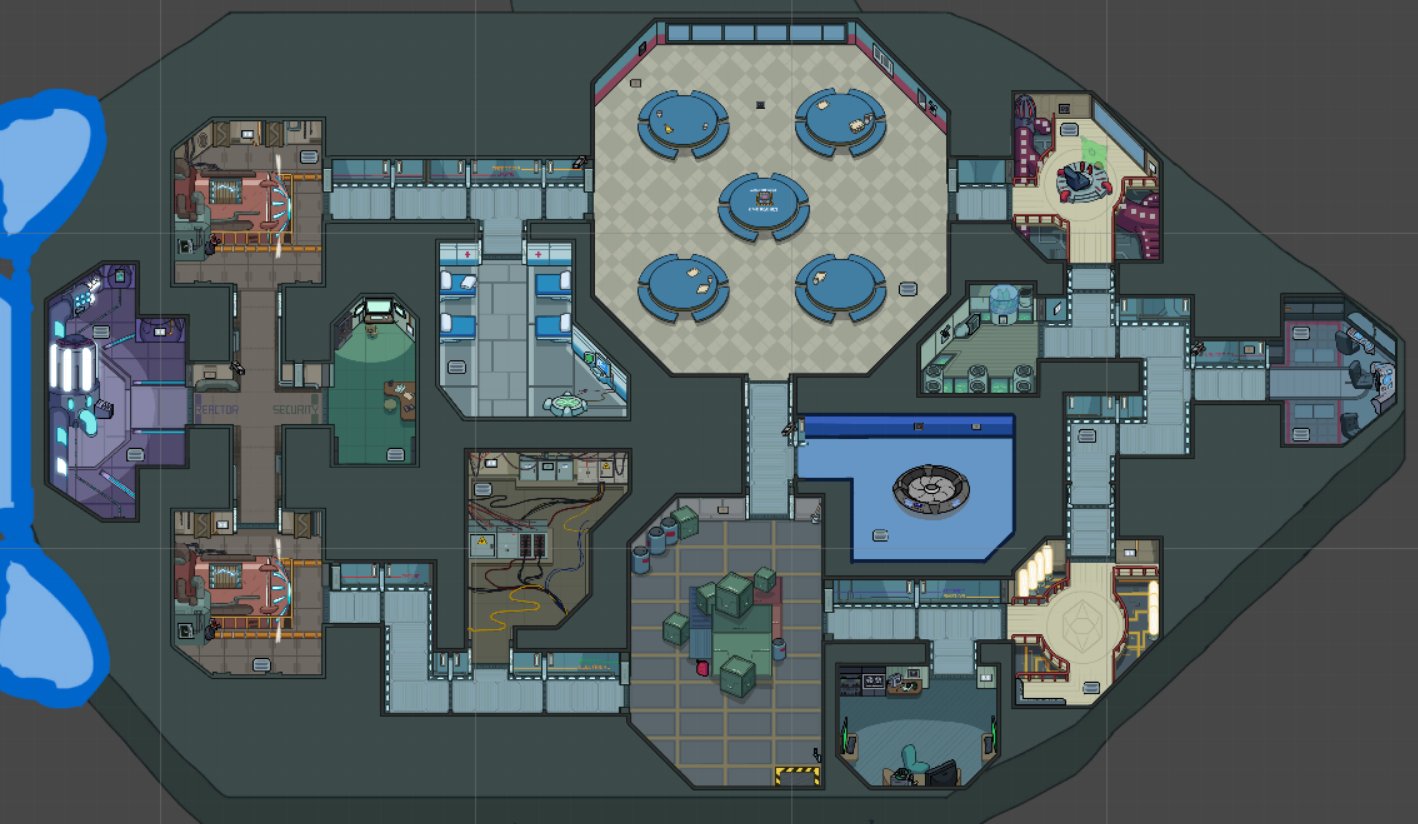
Welcome to this very exciting lesson on how to create Among Us in Unity. For this lesson, we will be creating the Field of View or Shadow Casting system. This makes it so you can only see players and objects within your line of sight.
LightCasting script on GitHub https://github.com/ckawell/LightShafting
We will make a few modifications to this script and then we will apply it to our player prefab. To set up the scene we will need to have to layers one for things that are shown in the shadows and one for things that are revealed in the light. We will then need to have two cameras one for the dark and one for the light. This is done by setting the Culling Masks of the camera. After which we will need to create a render texture for capturing the view of our light camera. This render texture will then be applied through a material onto a mesh in our scene. Finally, we will use the LightCaster script to dynamically update our render texture mesh to fit the visible space around our player.
Shader Script: https://gamedev.stackexchange.com/questions/109810/masking-with-3d-object-in-unity

lightcaster.cs
using System.Collections;
using System;
using System.Collections.Generic;
using UnityEngine;
public class lightcaster : MonoBehaviour
{
[SerializeField] LayerMask ignoreMe;
[SerializeField] float getRadius;
[SerializeField] LayerMask wallMask;
public Collider [] sceneObjects; //The objects in the scene to effect the lighting.
private Mesh mesh; //The light mesh.
public GameObject lightRays; //the light game object.
public float offset = 0.0001f; //the offset of the two rays cast to the left and right of each vertex of the scene objects.
public bool showRed; //For debugging: shows the red rays casted (the negative offset rays).
public bool showGreen; //For debugging: shows the green rays casted (the positive offset rays).
public struct angledVerts{ //used for updating the vertices and UVs of the light mesh. The angle variable is for properly sorting the ray hit points.
public Vector3 vert;
public float angle;
public Vector2 uv;
}
// Use this for initialization
void Start () {
mesh = lightRays.GetComponent<MeshFilter>().mesh; //inits the mesh of the light.
}
/// <summary>
/// Adds three ints to the end of an int array.
/// </summary>
/// <param name="original"></param>
/// <param name="itemToAdd1"></param>
/// <param name="itemToAdd2"></param>
/// <param name="itemToAdd3"></param>
/// <returns></returns>
public static int[] AddItemsToArray (int[] original, int itemToAdd1, int itemToAdd2, int itemToAdd3) {
int[] finalArray = new int[ original.Length + 3 ];
for(int i = 0; i < original.Length; i ++ ) {
finalArray[i] = original[i];
}
finalArray[original.Length] = itemToAdd1;
finalArray[original.Length + 1] = itemToAdd2;
finalArray[original.Length + 2] = itemToAdd3;
return finalArray;
}
/// <summary>
/// Adds two arrays together, making a third array.
/// </summary>
/// <param name="first"></param>
/// <param name="second"></param>
/// <returns></returns>
public static Vector3[] ConcatArrays(Vector3[] first, Vector3[] second){
Vector3[] concatted = new Vector3[first.Length + second.Length];
Array.Copy(first, concatted, first.Length);
Array.Copy(second, 0, concatted, first.Length, second.Length);
return concatted;
}
// Update is called once per frame
void Update()
{
GetWalls();
mesh.Clear(); //clears the mesh before changing it.
// The next few lines create an array to store all vertices of all the scene objects that should react to the light.
Vector3[] objverts = sceneObjects[0].gameObject.GetComponent<MeshFilter>().mesh.vertices;
for (int i = 1; i < sceneObjects.Length; i++)
{
objverts = ConcatArrays(objverts, sceneObjects[i].GetComponent<MeshFilter>().mesh.vertices);
}
//these lines (1) an array of structs which will be used to populate the light mesh and (2) the vertices and UVs to ultimately populate the mesh.
// (the "*2" is because there are twice as many rays casted as vertices, and the "+1" because the first point in the mesh should be the center of the light source)
angledVerts[] angleds = new angledVerts[(objverts.Length*2)];
Vector3[] verts = new Vector3[(objverts.Length*2)+1];
Vector2[] uvs = new Vector2[(objverts.Length*2)+1];
//Store the vertex location and UV of the center of the light source in the first locations of verts and uvs.
verts[0] = lightRays.transform.worldToLocalMatrix.MultiplyPoint3x4(this.transform.position);
uvs[0] = new Vector2(lightRays.transform.worldToLocalMatrix.MultiplyPoint3x4(this.transform.position).x, lightRays.transform.worldToLocalMatrix.MultiplyPoint3x4(this.transform.position).y);
int h = 0; //a constantly increasing int to use to calculate the current location in the angleds struct array.
for (int j = 0; j < sceneObjects.Length; j++) //cycle through all scene objects.
{
for (int i = 0; i < sceneObjects[j].GetComponent<MeshFilter>().mesh.vertices.Length; i++) //cycle through all vertices in the current scene object.
{
Vector3 me = this.transform.position;// just to make the current position shorter to reference.
Vector3 other = sceneObjects[j].transform.localToWorldMatrix.MultiplyPoint3x4(objverts[h]); //get the vertex location in world space coordinates.
float angle1 = Mathf.Atan2(((other.y-me.y)-offset),((other.x-me.x)-offset));// calculate the angle of the two offsets, to be stored in the structs.
float angle3 = Mathf.Atan2(((other.y-me.y)+offset),((other.x-me.x)+offset));
RaycastHit hit; //create and fire the two rays from the center of the light source in the direction of the vertex, with offsets.
Physics.Raycast(transform.position, new Vector2( (other.x-me.x)-offset , (other.y-me.y)-offset ) , out hit, 100, ~ignoreMe);
RaycastHit hit2;
Physics.Raycast(transform.position, new Vector2( (other.x-me.x)+offset , (other.y-me.y)+offset ), out hit2, 100, ~ignoreMe);
//store the hit locations as vertices in the struct, in model coordinates, as well as the angle of the ray cast and the UV at the vertex.
angleds[(h*2)].vert = lightRays.transform.worldToLocalMatrix.MultiplyPoint3x4(hit.point);
angleds[(h*2)].angle = angle1;
angleds[(h*2)].uv = new Vector2(angleds[(h*2)].vert.x, angleds[(h*2)].vert.y);
angleds[(h*2)+1].vert = lightRays.transform.worldToLocalMatrix.MultiplyPoint3x4(hit2.point);
angleds[(h*2)+1].angle = angle3;
angleds[(h*2)+1].uv = new Vector2(angleds[(h*2)+1].vert.x, angleds[(h*2)+1].vert.y);
h++;//increment h.
if(showRed && hit.collider != null)//for debugging: draw the rays cast.
{
Debug.DrawLine(transform.position, hit.point, Color.red);
}
if(showGreen)
{
Debug.DrawLine(transform.position, hit2.point, Color.green);
}
}
}
Array.Sort(angleds, delegate(angledVerts one, angledVerts two) {
return one.angle.CompareTo(two.angle);
});//sort the struct array of vertices from smallest angle to greatest.
for (int i = 0; i < angleds.Length; i++)//store the values in the struct array in verts and uvs.
{ //(offsetting one because index 0 is the center of the light source and triangle fan)
verts[i+1] = angleds[i].vert;
uvs[i+1] = angleds[i].uv;
}
mesh.vertices = verts; //update the actual mesh with the new vertices.
for (int i = 0; i < uvs.Length; i++)//offset all the UVs by .5 on both s and t to make the texture center be at the object center.
{
uvs[i] = new Vector2 (uvs[i].x + .5f, uvs[i].y + .5f);
}
mesh.uv = uvs; //update the actual mesh with the new UVs.
int[] triangles = {0,1,verts.Length-1}; //init the triangles array, starting with the last triangle to orient normals properly.
for (int i = verts.Length-1; i > 0; i--) //add all triangles to the triangle array, determined by three verts in the vertex array.
{
triangles = AddItemsToArray(triangles, 0, i, i-1);
}
//triangles = AddItemsToArray(triangles, 0, 1, 2);
mesh.triangles = triangles; //update the actual mesh with the new triangles.
}
void GetWalls()
{
sceneObjects = Physics.OverlapSphere(transform.position, getRadius, wallMask);
}
}
MaskShader.shader
// Upgrade NOTE: replaced 'mul(UNITY_MATRIX_MVP,*)' with 'UnityObjectToClipPos(*)'
Shader "Unlit/ScreenspaceTexture"
{
Properties
{
_MainTex ("Texture", 2D) = "white" {}
}
SubShader
{
Tags { "RenderType"="Opaque" "Queue"="Geometry"}
LOD 100
Lighting Off
Pass
{
CGPROGRAM
#pragma vertex vert
#pragma fragment frag
// make fog work
#pragma multi_compile_fog
#include "UnityCG.cginc"
struct appdata
{
float4 vertex : POSITION;
float2 uv : TEXCOORD0;
};
struct v2f
{
float3 screenPos : TEXCOORD0;
UNITY_FOG_COORDS(1)
float4 vertex : SV_POSITION;
};
sampler2D _MainTex;
float4 _MainTex_ST;
v2f vert (appdata v)
{
v2f o;
o.vertex = UnityObjectToClipPos(v.vertex);
o.screenPos = o.vertex.xyw;
// This might be platform-specific. Test with OpenGL.
o.screenPos.y *= -1.0f;
UNITY_TRANSFER_FOG(o,o.vertex);
return o;
}
fixed4 frag (v2f i) : SV_Target
{
// sample the texture
float2 uv = (i.screenPos.xy / i.screenPos.z) * 0.5f + 0.5f;
uv.y = 1.0 - uv.y;
fixed4 col = tex2D(_MainTex, uv);
// apply fog
UNITY_APPLY_FOG(i.fogCoord, col);
return col;
}
ENDCG
}
}
}

